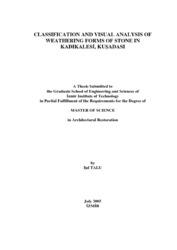Please use this identifier to cite or link to this item:
https://hdl.handle.net/11147/3236Full metadata record
| DC Field | Value | Language |
|---|---|---|
| dc.contributor.advisor | Böke, Hasan | - |
| dc.contributor.author | Talu, Işıl | - |
| dc.date.accessioned | 2014-07-22T13:51:10Z | - |
| dc.date.available | 2014-07-22T13:51:10Z | - |
| dc.date.issued | 2005 | - |
| dc.identifier.uri | http://hdl.handle.net/11147/3236 | - |
| dc.description | Thesis (Master)--Izmir Institute of Technology, Architectural Restoration, Izmir, 2005 | en_US |
| dc.description | Text in English; Abstract: Turkish and English | en_US |
| dc.description | xi, 76 leaves | en_US |
| dc.description.abstract | Identification of the state of deterioration at stone monuments is one of the main steps, which should be carried out for planning of conservation studies.In recent years, most of the study concerning the classification and mapping of weathering forms observed at stone monuments have been carried out either by detailed classification or sketchy methods.Due to the large area of the archaeological site, identification of the weathering forms of stones and their progress should be done in easy and rapid way to decide urgent interventions. This study was aimed to propose a visual presentation technique for classification and mapping of weathering forms of stones that it could be applied easily in archeological sites. For this aim, a method has been developed in the archeological site of Kadıkalesi (Anaia). The method was derived from detailed and sketchy classification methods. Both methods were united in order to form an intermediary scale for the visual classification and mapping forms observed at stone monuments.The proposed method for classification and mapping of weathering forms of stone in this study would be suitable for archeological sites. The most frequently observed weathering form in Kadikalesi is biological colonization, which is major cause of the loss of stone blocks and fissures. The deposition of the soluble salts, which could be originated from soil and marine aerosols and clay minerals, which ensures suitable conditions for the biological growth, are the other major causes of the stone, brick and mortar deterioration. This study indicated that during and after excavation in an archeological site, deposited soil and soluble salts on the stone surfaces should be cleaned to prevent rapid deterioration. Repairing or sealing cracks, cavities of stones, hand pulling wild grass will also prevent rapid deterioration of stones by the formation of higher plants. | en_US |
| dc.language.iso | en | en_US |
| dc.publisher | Izmir Institute of Technology | en_US |
| dc.rights | info:eu-repo/semantics/openAccess | en_US |
| dc.subject.lcc | TH9039 .T137 2005 | en |
| dc.subject.lcsh | Historic sites--Conservation and restoration--Turkey | en |
| dc.subject.lcsh | Weathering of buildings | en |
| dc.subject.lcsh | Monuments | en |
| dc.title | Classification and Visual Analysis of Weathering Forms of Stone in Kadıkalesi, Kuşadası | en_US |
| dc.type | Master Thesis | en_US |
| dc.institutionauthor | Talu, Işıl | - |
| dc.department | Thesis (Master)--İzmir Institute of Technology, Conservation and Restoration of Cultural Heritage | en_US |
| dc.relation.publicationcategory | Tez | en_US |
| dc.identifier.wosquality | N/A | - |
| dc.identifier.scopusquality | N/A | - |
| item.languageiso639-1 | en | - |
| item.cerifentitytype | Publications | - |
| item.openairetype | Master Thesis | - |
| item.openairecristype | http://purl.org/coar/resource_type/c_18cf | - |
| item.fulltext | With Fulltext | - |
| item.grantfulltext | open | - |
| Appears in Collections: | Master Degree / Yüksek Lisans Tezleri | |
Files in This Item:
| File | Description | Size | Format | |
|---|---|---|---|---|
| T000374.pdf | MasterThesis | 29.46 MB | Adobe PDF |  View/Open |
CORE Recommender
Page view(s)
358
checked on Jun 10, 2025
Download(s)
338
checked on Jun 10, 2025
Google ScholarTM
Check
Items in GCRIS Repository are protected by copyright, with all rights reserved, unless otherwise indicated.